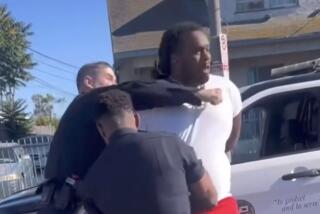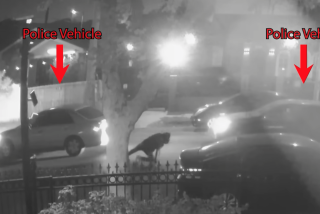Officer’s work was a calling
Patrolling Watts one day years ago, Los Angeles Police Capt. James Craig spotted a van in the street with a crowd of children gathered around.
The van’s occupant looked familiar. It was his former partner, Officer Randal Simmons, a rising star, in plain clothes and off-duty, doing what few other cops would do: He was trolling the same neighborhoods where he usually made arrests, looking for children to mentor as part of a church ministry.
As Craig watched, he noticed that Simmons knew the children’s first names, their personal struggles and their problems with gangs.
It was a typical effort by an officer for whom police work was more than just a job. The calling extended into the rest of his life -- from mentoring youth in South Los Angeles to charity efforts.
“Passionate about the job and passionate about making a difference in the community” is how Craig described him.
Simmons had been on the police force 27 years, 20 of them in SWAT, when he was mortally wounded early Thursday morning after he and other SWAT team members broke through the front door of a San Fernando Valley home where a gunman had killed family members. Police said they entered the home believing wounded people might be inside and others could be at risk of being shot and killed.
Simmons, 51, had tried as a young man for a career as a professional football player and was active in Police Department sports leagues, playing for the Centurions, the LAPD’s football club, and running in charity races. “He was a very outgoing guy, always smiling, always a kind word for everyone,” said LAPD Deputy Chief Charlie Beck.
On the job, the father of two -- a son, 15, and daughter, 13 -- stood out for his kindness and steady temperament. Simmons, originally from New York City, was the son of a minister, according to his former partner, retired LAPD Det. Gregory Grant. Simmons graduated from Fairfax High School in 1974, where he ran varsity track, Los Angeles Unified School District officials said.
He studied criminology at Washington State University, and wore No. 17 as a cornerback in 1976, 1977 and 1978. His final year, he was a varsity starter, according to the university’s sports information office.
Although Simmons was the strongest guy on the team, able to bench-press more than 400 pounds, his friend and college teammate Greg Sykes remembers with a laugh that Simmons “couldn’t catch a ball to save his life.”
Teammates would joke that the ball would hit Simmons anywhere but his hands, Sykes said.
After college, Simmons was briefly a Dallas Cowboys hopeful, friends said. But his pro football dreams were cut short by an injury, and he turned to police work. In 1981, he was assigned as a probationary officer to the LAPD’s Pacific Division, one of three African American probationers in the region at that time, Craig said.
Later, he worked in the South Bureau’s gang squad, known then as CRASH.
Grant said Simmons was a physically imposing officer -- “an Adonis” -- known for his superb physical fitness, for connecting with people and for maintaining his calm. Size alone was not the reason he had so few confrontations on the job. “We just talked to people. We had them laughing on the way to jail,” Grant said. “He was really able to communicate with people -- able to extract information from unwilling people. He made them comfortable, and put humanity into it.”
When he encountered resistance, he appealed to people’s sense of right and wrong, Grant said. Only the most pathological suspects did not respond, he said.
Simmons also worked as an officer in the LAPD’s 77th Street Division, the high-crime precinct that covers Hyde Park and part of the Crenshaw area, and as a vice officer in the Southeast Division in Watts in the 1980s, Craig said. During that stint, Simmons was shot and suffered a minor injury, Craig said. When Simmons was promoted to SWAT, one of the department’s most elite and highly coveted jobs, his calm negotiating style stood out in standoffs with suspects in high-pressure hostage situations.
Rick Massa, Simmons’ longtime SWAT team partner and colleague, recalled Simmons’ cool head under fire during a hostage negotiation in 1992.
Officers were trying to rescue a maid held captive at an airport hotel by religious zealot Rollen Frederick Stewart, better known as Rainbow Man, for the multicolored wigs he wore at televised sporting events. Massa said he couldn’t get through to Stewart, so he called on Simmons.
Simmons chatted with Stewart for hours, dissecting the meaning of various biblical passages from morning through the evening, buying officers precious time to formulate a plan and rescue the hotel employee.
One of his assignments in SWAT was to be the contact person for charity efforts, including an annual toy drive at Los Angeles Orthopaedic Hospital south of downtown.
He was “not only incredibly friendly, but really interested in being of service. You could tell,” said Jeffrey Klein, former head of fundraising for Orthopaedic Hospital, now with Providence St. Joseph Medical Center.
Simmons’ Christian faith was central to his character. Friends recalled him gently prodding them to go to church, to “get right with God.”
He prodded them about health matters too, telling them to drink soy milk and offering workout pointers. At 51, said Det. Donald Payne, a football friend, he looked 31. “Some people defy time,” he said.
Simmons was helping his church, Glory Christian Fellowship International in Carson, build a gymnasium, and would head straight for the facility after working out, Massa said.
With the church’s support, he worked off-hours mentoring youth in South Los Angeles, Craig said.
His youth ministry absorbed his off-hours, said his SWAT partner of seven years, Officer James Hart, 48.
On Sunday mornings, he picked up children from the Hacienda Village and Avalon Gardens housing developments, and drove them to services at Glory Christian. Hart recalled working crime-suppression patrols in the Avalon Gardens area. Simmons would ask, “James, you mind if I go check on my babies?” And they would drive over to visit some of the children he ministered to. “It was amazing, they would see him, and all these kids would just light up and yell, ‘Randy! Randy!’ ”
Simmons excelled at making arrests, Hart said. On patrol, the two men were “like sharks,” Hart said, observing, waiting -- homing in on a drug deal here, a stolen car there.
They disagreed on some subjects -- Simmons’ devotion to the Raiders, for instance -- but in action, they were in sync, communicating in their own secret code of Judo terms.
In the gym, a few days ago, Hart recalled Simmons striding in wearing a blue beanie, white shirt and black high-tops with no socks.
To his co-workers, he looked like a jailbird. And they were merciless.
“I gotta suspect right here outta Folsom!” Hart announced. “Hey, what’s your CDC number?” Simmons laughed and played along.
Hart was at home when he got the phone call summoning him to the hospital. Simmons was already dead.
“He was just a beautiful personality. I never had a brother, an older brother, but he was truly my brother,” Hart said. “Randy would say, even about this man who cost him his life, ‘Pray for him.’ ”
With 20 years on the job, he could have easily retired, colleagues said, but chose not to because he liked the work.
At the same time, he was a devoted family man.
His marriage, to Lisa, over some two decades impressed colleagues in a profession notorious for destroying relationships, Grant said.
Grant recalled Simmons on his wedding day. The athletic, confident, muscular police officer had a whole different mien at the altar, he said.
“He was trembling, tears running off his chin,” Grant recalled.
Simmons is survived by his wife, his two children, his parents and other family members.
--
andrew.blankstein @latimes.com
Times staff writers Susannah Rosenblatt and Sam Farmer contributed to this report.
More to Read
Sign up for Essential California
The most important California stories and recommendations in your inbox every morning.
You may occasionally receive promotional content from the Los Angeles Times.










